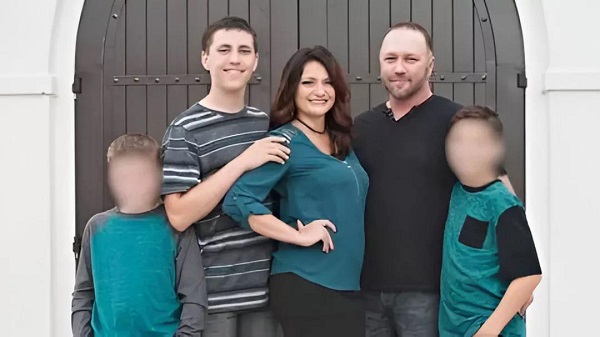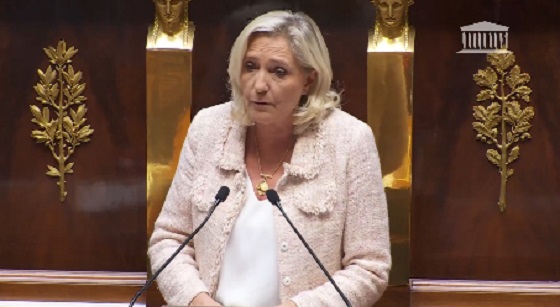illegal immigration
Feds can’t find foreign nationals released into US as terrorism threats heightened

Concertina wire is installed along the banks of the Rio Grande River as part of “Operation Lone Star,” Texas Gov. Greg Abbott’s border security mission.
From The Center Square
By
Nine months after the U.S. Department of Homeland Security Office of Inspector General expressed alarm that under the Biden administration, DHS agencies couldn’t locate where illegal foreign nationals were after they released them into the U.S., ongoing problems persist and terrorism threats are heightened.
Last September, the DHS OIG released a redacted report stating that DHS “does not have assurance that all migrants can be located once they are released into the United States.”
It conducted an audit over a 17-month period when DHS released more than 1.3 million foreign nationals into the U.S. after they illegally entered through the southwest border.
Of the 981,671 Border Patrol records evaluated from March 2021 through August 2022, addresses for more than 177,000 foreign nationals, or nearly 20%, “were either missing, invalid for delivery, or not legitimate residential locations,” it found.
The OIG also found that during this period, Border Patrol agents released 430,000 illegal foreign nationals into the U.S. on their own recognizance with Notice to Appear documents to go before an immigration judge. They released nearly 95,000 with Notice to Report documents to go to an Immigration and Customs Enforcement (ICE) office and more than 318,000 through a new Parole Plus Alternatives to Detention (Parole + ATD) program.
Under the Biden administration, instead of being processed for removal, foreign nationals deemed inadmissible were granted Parole + ATD and released into the U.S. They were also tracked with electronic devices either through wearing ankle bracelets or being given smartphones “intended to ensure compliance with release conditions, court hearings, and final orders of removal,” the report notes.
Prior to releasing them, federal agents are required to vet them to ensure they don’t have a criminal record and aren’t connected to countries of foreign concern or terrorist organizations. Federal agents are also required to obtain an address of where they are going in order to enforce federal immigration law.
The OIG found that DHS agencies had “limited ability” to accurately and effectively track them. Border Patrol “cannot always obtain and does not always record migrant addresses” and ICE “does not always validate migrant addresses prior to their release.”
Border Patrol agents didn’t accurately and effectively capture valid addresses, the report notes, because they were inundated with large influxes of people arriving at the border and because of “limited coordination with ICE and its limited authority to administer compliance with address requirements.” The audit found that “ICE also did not have adequate resources to validate and analyze migrants’ post-release addresses.”
ICE is statutorily required to enforce federal immigration law, specifically detaining and removing inadmissibles. “ICE must be able to locate migrants to enforce immigration laws, including to arrest or remove individuals who are considered potential threats to national security,” the OIG said. “The notable percentage of missing, invalid for delivery, or duplicate addresses on file means DHS may not be able to locate migrants following their release into the United States. As the Department continues to apprehend and release tens of thousands of migrants each month, valid post-release addresses are essential.”
Prior to this audit, the OIG found that DHS processes allowed known or suspected terrorist to illegally enter the U.S. and “potentially threaten national security and public safety.”
The report was released nearly 22 years after the 9/11 terrorist attacks. The terrorist attacks prompted the creation of DHS, consolidating several federal agencies all mandated to protect Americans and prevent another terrorist attack from occurring.
Within the last nine months, the OIG continued to report on DHS failures and authorities nationwide have issued heightened terrorist warnings.
One OIG audit found that U.S. Customs and Border Protection (CBP) and U.S. Citizenship and Immigration Services (USCIS) weren’t effectively screening asylum seekers – meaning they didn’t know who they were releasing into the country.
Another OIG report found that CBP and ICE weren’t detaining and removing inadmissables arriving at a major international airport – with 44% flagged for removal not showing up for their removal flights because federal agents had released them.
Another OIG audit found that DHS, CBP, USCIS and ICE agents didn’t properly vet or resolve derogatory information for tens of thousands of Afghans released into the U.S. After the Biden administration pulled U.S. forces out of Afghanistan in August 2021, 97,000 Afghans were brought to the U.S. Among them, 77,000, or 79%, were granted humanitarian parole into the U.S. allowing them to stay for two years.
The OIG expressed alarm about DHS not having a process “for monitoring parole expiration” after the two-year period ended in August 2023, meaning no plans were in place to remove them.
As numerous officials have warned a terrorist attack on U.S. soil is imminent and members of Congress have demanded answers, an unprecedented estimated 12 million people from over 150 countries have illegally entered the U.S. since the president has been in office.
espionage
Inside Xi’s Fifth Column: How Beijing Uses Gangsters to Wage Political Warfare in Taiwan — and the West

A new Jamestown Foundation report details how China’s Ministry of State Security and allied triads have been used to subvert Taiwan’s democracy as part of Beijing’s united front.
Editor’s Note
The Bureau has previously reported on how Chinese state-linked crime networks have exploited Canada’s real estate market, casinos, and diaspora associations, often under the cover of united front work. One of these groups, the Chinese Freemasons, has been linked to meetings with Canadian politicians, as reported by The Globe and Mail ahead of the 2025 federal election. The Globe noted that the Toronto chapter explicitly advocates for the “peaceful reunification of Taiwan.” The Jamestown Foundation’s new findings on groups active in Taiwan — including the Chinese Freemasons, also known as the Hongmen, the related Bamboo Union triad, and the China Unification Promotion Party (CUPP) — show that Taiwan is the epicenter of a strategy also visible, though less intensively, across democracies including the United States. The parallels — from Vancouver to Sydney to New York to Taipei — should alert governments that the “fifth column” problem is international, and it is growing.
TAIPEI — At a banquet in Shenzhen more than two decades ago, Chang An-lo — the Bamboo Union boss known as “Big Brother Chang” or “White Wolf” — raised a glass to one of the Communist Party’s princelings. His guest, Hu Shiying, was the son of Mao Zedong’s propaganda chief. “Big Brother Chang,” Hu reportedly toasted him, an episode highlighted in a new report from the Jamestown Foundation.
Hu would later be described by Australian journalist John Garnaut as an “old associate of Xi Jinping.” That link — through Hu and other princelings Chang claimed to have met — placed the Bamboo Union leader within the orbit of Party elites. Garnaut also reported that the Ministry of State Security (MSS) had used the Bamboo Union to channel lucrative opportunities to Taiwanese politicians. According to Jamestown researcher Martin Purbrick, a former Royal Hong Kong Police intelligence officer, such episodes show how the CCP has systematically co-opted Taiwanese organized crime as part of its united front strategy.
“The long history of links between the CCP and organized crime groups in Taiwan,” Purbrick writes, “shows that United Front strategy has embedded itself deeply into Taiwan’s political life.”
Chang’s global influence is not a relic of the past. The Bureau reported, drawing on leaked 1990s Canadian immigration records, that intelligence indicated Chang’s triad had effectively “purchased” the state of Belize, on Mexico’s southern border, for use in smuggling illegal immigrants into the United States. But Chang is more relevant than ever as fears of Beijing invading Taiwan grow. In August 2025, seated in his Taipei office before a PRC flag, he appeared on a YouTube program to deny he led any “fifth column.” Instead, he insisted Taiwan must “embrace” Beijing and cast himself as a “bridge for cross-strait peace.”
His denial came just months after Taiwan’s Ministry of Justice accused CUPP of acting as a political front for organized crime and foreign interference. Police suspected more than 130 members of crimes ranging from homicide to drug trafficking. Prosecutors charged CUPP operatives with taking $2.3 million from the CCP to fund propaganda. In January, the Ministry of the Interior moved to dissolve the party outright, submitting the case to Taiwan’s Constitutional Court. By March, a Kaohsiung court sentenced CUPP deputy secretary-general Wen Lung and two retired military officers for recruiting Taiwanese personnel on behalf of the PRC. According to court filings, Wen had been introduced by Chang to the Zhuhai Taiwan Affairs Office, which in turn connected him to a PLA liaison officer.
President Lai Ching-te, in a March national security address, warned that Beijing was attempting to “divide, destroy, and subvert us from within.” Intelligence assessments in Taipei describe the Bamboo Union and CUPP as part of a potential “fifth column,” prepared to foment unrest and manipulate opinion in the event of an invasion.
The historical record shows why Taipei is so concerned. Chang’s name has shadowed some of Taiwan’s darkest chapters. In the 1980s, he was suspected of involvement in the assassination of dissident writer Henry Liu in California. He was later convicted of heroin smuggling in the United States, serving ten years in prison. After returning to Taiwan, he fled again in 1996 when authorities sought his arrest, spending 17 years in Shenzhen. During those years, he cultivated ties with influential Party families. At the Shenzhen banquet, Washington Post journalist John Pomfret wrote, Hu Shiying introduced him as “Big Brother Chang,” signaling acceptance in elite circles. Garnaut, writing over a decade later, noted that Hu was an “old associate of Xi Jinping” and that Chang had moved comfortably among other princelings, including sons of a former CCP general secretary and a top revolutionary general.
These connections translated into political capital. When Chang returned to Taiwan in 2013, he launched the China Unification Promotion Party — a pro-Beijing group openly advocating “one country, two systems.” He declared his mission was to “cultivate red voters.” CUPP cadres and Bamboo Union affiliates became visible in street politics, clashing with independence activists and disrupting rallies. During U.S. Speaker Nancy Pelosi’s 2021 visit, they staged counter-protests echoing Beijing’s line.
The ideological warfare runs even deeper. A Phoenix TV segment from 2011 recalled how a Bamboo Union elder declared in 1981 that he “would rather the CCP rule Taiwan than have Taiwan taken away by Taiwan independents.” Chang himself has echoed this sentiment for decades. In 2005, he launched a Guangzhou-based group called the Defending China Alliance, later rebranded in Taipei as CUPP. His activism has spanned disruptive protests, nationalist rallies, and propaganda campaigns amplified through China-linked media channels.
Purbrick situates these developments within a wider united front playbook. Taiwanese triads and Chinese Freemason associations are courted as grassroots mobilizers, intermediaries, and psychological enforcers. A recent report from the Washington Post has also linked the Chinese Freemasons to the powerful 14K Triad, a global network deeply implicated in Chinese underground banking networks accused of laundering fentanyl proceeds for Mexican cartels through the United States. The triad–Hongmen nexus complements other CCP efforts: online influence campaigns, cultural outreach, and intelligence recruitment inside Taiwan’s military.
The implications extend beyond Taiwan. In Canada, Australia, the United States, Southeast Asia, and beyond, intelligence agencies have documented how PRC-linked triads launder drug profits, fund political donations, and intimidate diaspora critics. These groups benefit from tacit state protection: their criminality overlooked so long as they advance Beijing’s strategic objectives. It is hybrid warfare by stealth — not soldiers storming beaches, but criminal syndicates reshaping politics from within.
For Taiwan, the Bamboo Union and CUPP remain immediate threats. For other democracies, they serve as case studies of how united front tactics adapt across borders. President Lai’s warning that Beijing seeks to “create the illusion that China is governing Taiwan” resonates internationally.
Before leaving journalism to establish an advisory firm, John Garnaut himself became entangled in the political fallout of his reporting. He was sued by a Chinese-Australian real estate developer from Shenzhen, who had funneled large donations to Australian political parties. The developer, later publicly implicated in the case by an Australian lawmaker under parliamentary privilege, successfully sued Garnaut for defamation in 2019. Subsequent disclosures confirmed the tycoon’s implication in an FBI indictment involving United Nations influence schemes and notorious Chinese operative Patrick Ho, later linked to a Chinese oil conglomerate accused of targeting the Biden family in influence operations. Together, these episodes highlight the global reach of united front networks.
Daily Caller
HUD Secretary Says Illegals May No Longer ‘Live In Taxpayer-Funded Housing’


From the Daily Caller News Foundation
By Hailey Gomez
U.S. Department of Housing and Urban Development (HUD) Secretary Scott Turner said Friday on Fox News’ “Jesse Watters Primetime” that illegal immigrants may no longer “live in taxpayer-funded housing.”
In March, Turner and Department of Homeland Security Secretary Kristi Noem announced the “American Housing Programs for American Citizens,” ending “the wasteful misappropriation of taxpayer dollars to benefit illegal aliens instead of American citizens.” Discussing how HUD plans to prevent illegal migrants from living in public housing, Turner said the department has already issued a letter to the D.C. Housing Authority requesting its full list of residents and those without U.S. citizenship.
“President Trump is serious not only in cleaning up the crime in our streets, but also American citizens will be prioritized when it comes to living in HUD-funded, government-funded housing,” Turner said. “We just sent out a letter to the D.C. Housing Authority, and it has been received by them. And, as you said, they have 30 days to give us a full, comprehensive account of everyone living inside of D.C. housing that are receiving Section 8 vouchers or any type of HUD funding.”
Dear Readers:
As a nonprofit, we are dependent on the generosity of our readers.
Please consider making a small donation of any amount here.
Thank you!
WATCH:
“We want the names, the address, the number of people in the unit, the size of the unit, the cost of the unit. And they must give us their American citizenship status or eligible immigration status. No longer will we allow illegal aliens to live in taxpayer-funded housing here in America. In the last administration, in the Biden administration, they turned a blind eye. They didn’t collect the data,” Turner added. “But those days are over. We are collecting the data to make sure they’re illegal aliens. And for that criminal activity, no one doing criminal activity is living in HUD-funded housing, which is literally on the backs of taxpayers in America.”
Under the Biden administration, the border crisis became a major issue for the president as officials estimated a total of 10.8 million encounters with illegal migrants since fiscal year 2021. With a massive influx of illegal immigrants coming into the United States, Democrat mayors of sanctuary cities like Denver and New York City eventually asked the administration for funding to address the issue in 2023.
By 2024, reports indicated that due to the surge of illegal immigrants, the U.S. had an estimated shortage of 4 million to 7 million housing units, with developers struggling to keep up with the demand for homes. In addition to housing concerns, rent in 2024 saw an increase of 20.9% since 2021, which had already risen due to inflation under Biden.
According to data from the Center for Immigration Studies, an estimated 59% of illegal immigrant households use one or more welfare programs, which costs taxpayers an estimated $42 billion.
-

 espionage22 hours ago
espionage22 hours agoInside Xi’s Fifth Column: How Beijing Uses Gangsters to Wage Political Warfare in Taiwan — and the West
-

 Daily Caller2 days ago
Daily Caller2 days ago‘You Have No Idea What You Have Unleashed’: Erika Kirk Addresses Supporters For First Time Since Kirk’s Assassination
-

 Censorship Industrial Complex22 hours ago
Censorship Industrial Complex22 hours agoDecision expected soon in case that challenges Alberta’s “safe spaces” law
-

 COVID-1915 hours ago
COVID-1915 hours agoWhy FDA Was Right To Say No To COVID-19 Vaccines For Healthy Kids
-

 Energy15 hours ago
Energy15 hours agoTrump Admin Torpedoing Biden’s Oil And Gas Crackdown
-

 Crime2 days ago
Crime2 days agoFormer NYPD Inspector Shares What Family Of Alleged Charlie Kirk Assassin Feared Before Turning Him In
-

 Education1 day ago
Education1 day agoOur kids are struggling to read. Phonics is the easy fix
-

 Crime14 hours ago
Crime14 hours agoTransgender Roomate of Alleged Charlie Kirk Assassin Cooperating with Investigation







